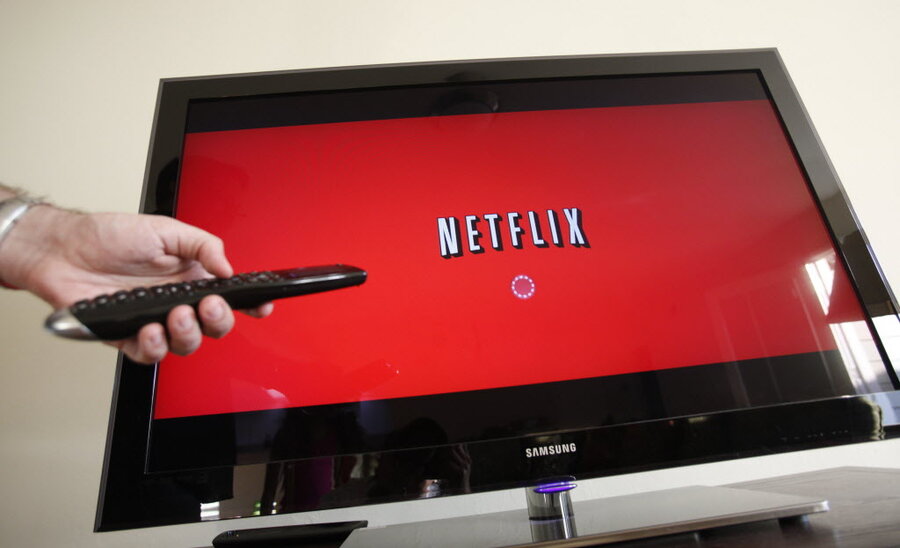Most popular 'TV network' in 2016? Netflix.
Loading...
What's poised to be the most popular "TV network" in 2016? Not NBC, ABC, or CBS. Netflix.
That's according to analyst firm FBR Capital Markets, which predicted that Netflix will have a larger audience than all the major broadcast networks within a year, underscoring the streaming media company's soaring popularity in recent years.
"If Netflix were a Nielsen-rated TV network, the No. 1 streaming service would, within a year, attain a larger 24-hour audience than each of the major broadcast networks – ABC, CBS, Fox and NBC – according to a Wall Street analyst firm," Variety, which first reported the story, wrote.
According to FBR's report, Netflix already boasts audiences rivaling those of ABC and NBC. With its impressive growth rate, the firm predicts it will also surpass CBS and Fox by 2016.
That said, FBR's methodology isn't a perfect comparison. To compare audience viewership between the online and traditional television, analysts used Nielsen TV ratings for the major networks, which excludes online video views and only includes seven days worth of DVR and video-on-demand viewing, all of which are an increasing part of networks' audiences. It compared this with an estimate from Netflix's own report that estimated its viewers had streamed about 10 billion hours of video in the first quarter of 2015.
Nonetheless, the conclusion is clear: As it gains in popularity, Netflix is encroaching on network TV.
According to a survey also commissioned by FBR, when consumers were asked to choose between Netflix and cable (or satellite), 57 percent went with Netflix, while only 43 percent chose cable or satellite.
The streaming service, which currently boasts 62 million subscribers worldwide and is expected to gain 174 million subscribers by 2020, now accounts for almost 37 percent of all Internet traffic.
It's a staggering figure that underscores Netflix's soaring popularity.
What's behind Netflix's success?
For starters, it untethers viewers, allowing them to watch what they want, when they want, on whatever device they want, commercial-free, at about $8 per month, a fraction of the cost of cable.
That's especially important for cash-strapped younger generations who have come of age in an on-demand world.
"Cable TV companies have long operated as monopolies, alienating customers for a generation,” says John Baick, a professor of history who studies popular culture at Western New England University. "Millennials value internet access above cable access," he adds, a point Neflix understands.
The streaming service also offers a vast library of programming, including movies, vintage TV shows, and original programming like "House of Cards" and "Orange is the New Black," two Netflix-exclusive series that have attracted scores of viewers.
This type of "viewership buffet" appeals to today's viewers, says Baick, adding that "We are not passive viewers, but active consumers, hunting and gathering our way through the digital forest."
And of course, Netflix knows its consumer on a granular level.
"Netflix tracks not only its subscribers’ preferences and habits but also how quickly they watch each episode and how many episodes they watch in one night. It has organized its library into seventy-nine thousand categories – Foreign Sci-Fi & Fantasy, Dark Thrillers Based on Books – to better predict what you might want to watch next," the New Yorker reported last year.
The company can use that detailed information to customize and personalize a viewer's experience, a move that's likely to increase users' satisfaction and loyalty. If Netflix does indeed surpass all major TV networks next year, what does that mean for home viewership?
In its report, FBR suggested Netflix should charge more.
“Netflix subscribers clearly like it more than pay TV, which we see as arguing for pricing leverage, since pay TV, on average, costs over $80 per month,” the analysts wrote.
And while many have long predicted the death of TV, it offers something Netflix can't: appointment viewing. Events like the Olympics, the Super Bowl, the Oscars, even "American Idol," bring in massive amounts of viewers, which in turn, allow networks to charge large sums to advertisers. Thanks to events like these, as well as live sports, traditional networks will probably continue to have their place in Americans' homes.
And, Baick cautions, Netflix shouldn't get too comfortable."[C]an Netflix continue?" he asks. "The rumble in the distance is Amazon, and Google and Apple have entered the field with their algorithms and cash.”






